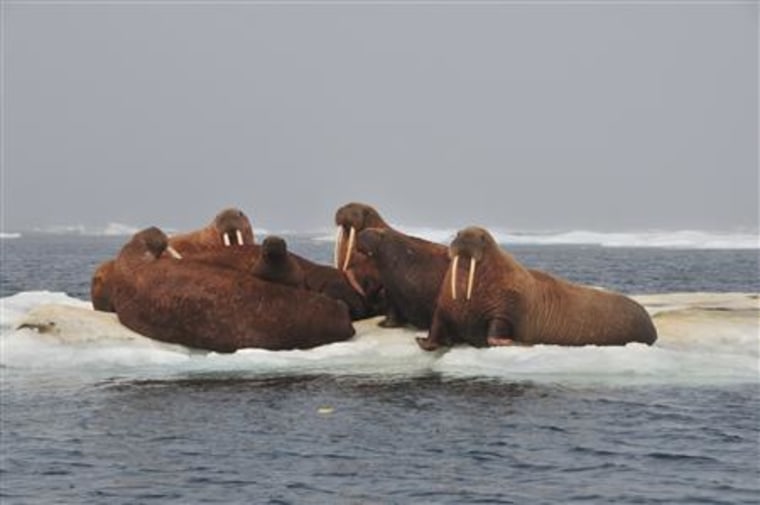Fast-melting Arctic sea ice appears to be pushing walruses to haul themselves out onto land, and many are moving around the area where oil leases have been sold, the U.S. Geological Survey reports.
Walruses are accomplished divers and frequently plunge hundreds of feet to the bottom of the continental shelf to feed. But they use sea ice as platforms to give birth, nurse their young and elude predators, and when sea ice is scarce or non-existent, as it has been this summer, they come up on land.
Last September, the loss of sea ice caused an estimated 10,000 to 20,000 walruses to venture onto land, and as sea ice melts reached a record last month, U.S. government scientists are working with Alaskan villagers to put radio transmitters on some of the hauled-out walruses to track their movements around the Chukchi Sea.
"The ice is very widely dispersed and there is little of it left over the continental shelf," researcher Chad Jay of the U.S. Geological Survey said in a statement on Wednesday. "Based on our tracking data, the walruses appear to be spreading out and spending quite a bit of time looking for sea ice."
The loss of sea ice puts Pacific walruses at risk, according to the U.S. Fish and Wildlife Service, but other, higher-priority species will get attention first. In February, the wildlife service listed Pacific walruses as candidates for protection, though not protection itself.
Walruses are protected under the Marine Mammal Protection Act, which means these animals cannot be harvested, imported, exported or be part of interstate commerce.
Polar bears, which also use sea ice in the Chukchi Sea as platforms for hunting, have been designated as threatened under the U.S. Endangered Species Act because of declining sea ice in the Arctic.
Compared to last year's massive haul-out, there are few walruses on land, and there is no solid count, Jay said.
"There is a lot less ice than there used to be on the continental shelf this time of year," he said. "So we might be headed into a new normal."
Transmissions from the radio-tagged walruses offer a good picture of where these creatures are in the Chukchi Sea in a U.S. Geological Survey graphic updated approximately weekly.
Viewable online, the graphic shows where the walruses were when they were first tagged (shown as red Xs) and how they moved around the water (shown as yellow dots).
The graphic also shows changes in sea ice cover in the far north, indicating nearly ice-free conditions in areas where the walruses are moving. Many are within the boundaries of an oil lease sale area that stretches along the northwestern Alaska coast and far into the Chukchi Sea.
Royal Dutch Shell, ConocoPhillips and Statoil hold leases in the Chukchi Sea, though no drilling has started.
Last month saw Arctic sea ice drop to its lowest extent — meaning that it covered the smallest area — for any July since satellite records began in 1979, according to the U.S. National Snow and Ice Data Center. Typically, Arctic sea ice hits its lowest extent for the year in September.
This record-low ice extent for July is lower than July ice extent in 2007, when ice extent shrank in September to its smallest area in the satellite record.
